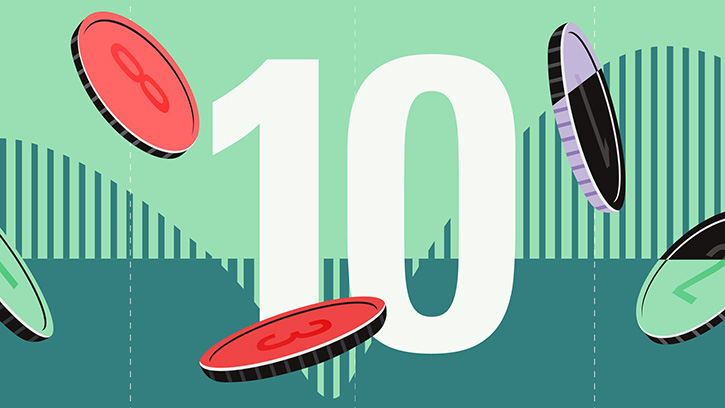Rolle im Portfolio
The CS ETF (CH) on SLI provides exposure to Swiss large-capitalisation equities and can be used as a core holding for investors looking to build a Swiss-centric portfolio. This fund can also be implemented as a tactical tool to overweight Swiss equities within a diversified portfolio. It could be useful for those who want to place a bet on the near-to-medium-term prospects of the Swiss market under the belief that it is undervalued.
The SLI can be used as an alternative to the SMI, the most significant equity benchmark in Switzerland. The SLI offers better single stock and sector diversification relative to the SMI thanks to a capping mechanism which limits the weighting of each of the four largest constituents to 9% of the index’s value, while the weighting of all other securities is capped at 4.5%. However, investors should be aware that the SLI remains fairly top heavy, with the top 10 constituents accounting for about 63% of its value. Financials and healthcare are the index’s top sectors, representing a combined 50% of the index’s value.
For non-Swiss investors, the CS ETF (CH) on SLI can also serve as a diversifier within a broad pan-European portfolio by providing exposure to one of the world’s most stable and strongest currencies. However non-Swiss investors should be mindful that a strengthening franc will enhance the return of this fund as denominated in their home currencies, but a weakening franc will weigh on its performance.
Fundamentale Analyse
Buoyant worldwide demand for Swiss goods supported Switzerland’s economy after the financial crisis, until the appreciation of the Swiss franc--driven by its safe haven status--became a problem. The persistent strength of the currency prompted the Swiss National Bank (SNB) to set the minimum exchange rate of the euro at 1.20 francs in September 2011. This shift, which resulted effectively in a “peg” of the currency to the euro, has since changed the role of Swiss franc-denominated assets in investors’ portfolios. That is to say that they’ve somewhat lost their safe haven appeal.
As of this writing, the cap remains in place and will continue to be enforced by the SNB with the utmost determination for as long as necessary. While the measures taken by the European Central Bank (ECB) to tackle the Euro zone crisis have helped restore investor confidence in the euro and, in turn, eased pressure on the Swiss franc, the Helvetic currency remains strong and still weighs on Swiss exporters, who see selling prices and profit margins squeezed.
Another concern for exporters such as Nestle, Richemont and Swatch has been the debt crisis in the Euro area --a major trading partner for Swiss companies. Despite some important moves towards a credible resolution of the crisis, the region’s negative economic outlook continues to depress consumer confidence and restrict spending in Europe. To offset slowing European consumption, Swiss companies have increased their exports to China and are now more dependent than ever on the latter’s economic growth. China is currently the fourth biggest importer of Swiss products behind Germany, the US and Italy. In 4 or 5 years, should the current trend continue, China is expected to become the second largest buyer of Swiss products after Germany.
Overall, the SLI consists of many high-quality companies that boast sustainable competitive advantages, or wide “economic moats”, by virtue of having either exclusive patents or well-recognised brand names. These include not only multinationals like Unilever or Richemont, but also defensive heavyweights Novartis and Roche which are able to maintain their competitive advantages with their portfolio of patented drugs and their robust R&D budgets, which support new drug discovery.
Indexkonstruktion
The Swiss Leader Index (SLI) consists of the 30 largest and most liquid stocks listed on the Swiss stock exchange. As such, the SLI is comprised of the SMI stocks plus the 10 largest stocks in the SMIM. The SLI has a capping mechanism. The four largest shares are each capped at 9% of the index’s value and where necessary, the weighting of the other securities is limited to 4.5%. Because the weightings change continuously, SIX Swiss Exchange calculates and adjusts the capping factor every three months. The financial and healthcare sectors are the most heavily weighted, representing about 25-28% and 21-24% of the index's value respectively, followed by industrials (18-20%) and consumer goods (16-18%). The top four constituents are Roche, Novartis, Nestle and UBS, each comprising between 8 and 10% of the index’s value.
Fondskonstruktion
The CS ETF (CH) on SLI uses physical replication to track the performance of the SLI on a total return basis. The fund owns the securities within the index. CS ETF (CH) on SLI engages in securities lending, which serves to generate additional revenue. While Credit Suisse allows up to 95% of a fund’s assets to be lent out, in practice average assets on loan at any one time is between 5% and 20% of the fund’s value --the average on-loan level was 4.4% in the year ended December 2012. For the Swiss ETFs, Credit Suisse borrows on a principal basis from the funds. In this case, the fund has counterparty exposure only to Credit Suisse. Credit Suisse may then on-lend the securities to a number of different market participants, but Credit Suisse stands between the fund and the counterparty risk of these other participants. To protect the fund, Credit Suisse provides collateral greater than the loan value on a daily basis into an account that is separate from the assets of Credit Suisse. Collateral levels vary from 102% to 115% of the loan amount, depending on the assets on loan and the assets provided as collateral. Collateral and loans are marked to market on a daily basis. At the time of writing, collateral is made up of a majority of government bonds and its value is equivalent at 105% of the loan's value. 50% of the gross securities lending revenues generated by Credit Suisse on behalf of the fund are passed on to the fund. Net return for the year ended June 2012 was 1%. Dividends (including withholding receivables) are reinvested in both the SLI constituents and SLI futures depending on the amount and timeframe until the next distribution date. Credit Suisse performs several interim distributions (up to five) especially during the first half of each calendar year due to the large number of dividends during that time. It is worth noting that Swiss-domiciled CS ETF (CH) on SLI is not compliant with UCITS and therefore is only authorised for commercial distribution in Switzerland and Liechtenstein.
Gebühren
This fund levies a total expense ratio (TER) of 0.39%, which is at the top end of the range for ETFs tracking the SLI. Additional costs potentially borne by the fund shareholder but not included in the TER include rebalancing costs, bid-ask spreads and brokerage fees when buy and sell orders are placed for ETF shares.
Alternativen
CS ETF (CH) on SLI is the largest fund tracking the SLI traded on the Swiss stock exchange. It is also the most liquid as measured by its trailing 3-month average daily trading volume. Providers including UBS and db x-trackers offer their own products tracking the SLI at a TER of 0.35%, but these lower fees may potentially come at the expense of lower liquidity.
As an alternative to the SLI, investors can turn to the SMI, the most popular benchmark index of the Swiss stock market. However, the SMI, which comprises 20 of the largest and most liquid stocks listed on the Swiss exchange, has a much higher degree of single stock and sector concentration. The top five constituents account for about 70% of the index’s value. Top constituent Nestle has a 23-25% weighting, while healthcare is the most represented sector with a 30-35% allocation. A handful of providers have an ETF tracking the SMI in their product range, CS ETF (CH) on SMI being the most widely-held fund of them all. At 0.39%, its TER is nonetheless higher than that of other ETFs, including ComStage ETF SMI, which levies a TER of 0.25%.
Die in diesem Artikel enthaltenen Informationen dienen ausschließlich zu Bildungs- und Informationszwecken. Sie sind weder als Aufforderung noch als Anreiz zum Kauf oder Verkauf eines Wertpapiers oder Finanzinstruments zu verstehen. Die in diesem Artikel enthaltenen Informationen sollten nicht als alleinige Quelle für Anlageentscheidungen verwendet werden.

















